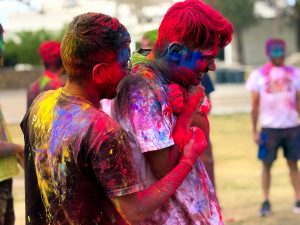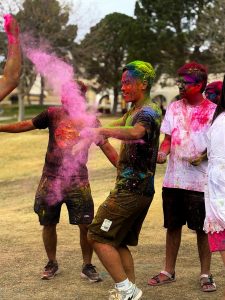On March 29, students welcomed the budding spring seasons with Holi, the Hindu festival of colors. There they threw colored chalk at one another to celebrate the victory of good over evil.
Holi celebrates the coming of spring, as well as the triumph of good over evil. Celebrated mainly in South Asia, the holiday is most known for the tradition of throwing vividly colored powers, called gulag, and water.
The holiday began around the fourth century, with there being many variations of the legend and how it came to be. One attendee, Anita Khatiwata, told the story of a struggle between a demon family and their son.
“Now in Hindu culture, it is said that there was a family of demons, but in the family was a very good worshiper of a god,” Khatiwata said. “The father and his aunt wanted him dead, so his aunt had gotten a blessing from the guard that won’t be killed by the fire. The aunt took the nephew in her lap and sat around the fire, but the guard intervened and saved the boy. Instead of the boy, the woman [who was] the demon was burned. So, it is believed as the win [over] the evil.”

The woman’s name was Holika, which is where the name Holi is derived from. The theme of triumph over evil is seen throughout the celebration and is not the only legend essential to the holiday.
The love story of the deities Radha and Krishna, whose skin was turned blue by a demon, explains the tradition of throwing colors.
According to History.com, Krishna was plagued by the worry Radha would reject him for his appearance and confided this worry to his mother. She suggested smearing color on Radha’s face, which led to Radha falling in love with Krishna. During Holi, as an ode to their love people throw colored powder and water at each other.
”Happiness and enjoy[ing] fullness; this is the meaning [of throwing color],” NMSU student Sussil Kactri said. “It signifies our victory over the evil eyes, and this has religious and cultural meaning in our society.”

Each color has significance; yellow meaning prosperity and new beginnings, blue represents Krishna, and so forth. One NMSU graduate assistant, Busca Dahal, explained the prominence of red during Holi, and how every other color centers it.
“The Holi is a red, and other colors are the shades of the red,” Dahal said. “So [the] red color clearly denotes the truth, and it’s like a fire that cleans everything, the evil, everything.”
This year Holi fell on March 13, leaving many South Asian students unable to celebrate do to them being far from their home countries; However, the event this year allowed for students to experience a piece of home. Dahal recalled the festival when he was younger living in Nepal, and the days of celebration that lead up to the day of Holi.
”People gather around [Basantapur, Nepal] and there will be more than 10,00 people just to celebrate our single Holi for a day,” Dahal said.

Many students from across majors came together to celebrate Holi at the university. People could be seen dancing for hours, growing more colorful by the minute. With provided chalk, people could be seen playfully chasing each other and throwing color at one another.
“Generally, we are far from home, and we don’t get to celebrate it. That day, it was supposed to [be celebrated] a few days earlier, but we didn’t get time to celebrate,” Anita Khatiwata said. “So when Asian and Pacific Islander [said they’d] organize it, we get to get together with all our communities and come here and play.”









